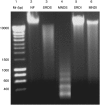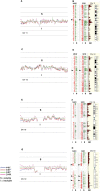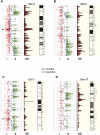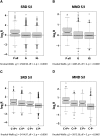Endonuclease-sensitive regions of human spermatozoal chromatin are highly enriched in promoter and CTCF binding sequences
- PMID: 19584098
- PMCID: PMC2720182
- DOI: 10.1101/gr.094953.109
Endonuclease-sensitive regions of human spermatozoal chromatin are highly enriched in promoter and CTCF binding sequences
Abstract
During the haploid phase of mammalian spermatogenesis, nucleosomal chromatin is ultimately repackaged by small, highly basic protamines to generate an extremely compact, toroidal chromatin architecture that is critical to normal spermatozoal function. In common with several species, however, the human spermatozoon retains a small proportion of its chromatin packaged in nucleosomes. As nucleosomal chromatin in spermatozoa is structurally more open than protamine-packaged chromatin, we considered it likely to be more accessible to exogenously applied endonucleases. Accordingly, we have used this premise to identify a population of endonuclease-sensitive DNA sequences in human and murine spermatozoa. Our results show unequivocally that, in contrast to the endonuclease-resistant sperm chromatin packaged by protamines, regions of increased endonuclease sensitivity are closely associated with gene regulatory regions, including many promoter sequences and sequences recognized by CCCTC-binding factor (CTCF). Similar differential packaging of promoters is observed in the spermatozoal chromatin of both mouse and man. These observations imply the existence of epigenetic marks that distinguish gene regulatory regions in male germ cells and prevent their repackaging by protamines during spermiogenesis. The ontology of genes under the control of endonuclease-sensitive regulatory regions implies a role for this phenomenon in subsequent embryonic development.
Figures






Similar articles
-
Nucleosomes in mammalian sperm: conveying paternal epigenetic inheritance or subject to reprogramming between generations?Curr Opin Genet Dev. 2023 Apr;79:102034. doi: 10.1016/j.gde.2023.102034. Epub 2023 Mar 7. Curr Opin Genet Dev. 2023. PMID: 36893482 Free PMC article. Review.
-
Key gene regulatory sequences with distinctive ontological signatures associate with differentially endonuclease-accessible mouse sperm chromatin.Reproduction. 2011 Jul;142(1):73-86. doi: 10.1530/REP-10-0536. Epub 2011 Apr 21. Reproduction. 2011. PMID: 21511886
-
High-resolution mapping of chromatin packaging in mouse embryonic stem cells and sperm.Dev Cell. 2014 Jul 14;30(1):11-22. doi: 10.1016/j.devcel.2014.05.024. Epub 2014 Jul 3. Dev Cell. 2014. PMID: 24998598 Free PMC article.
-
Paternal DNA packaging in spermatozoa: more than the sum of its parts? DNA, histones, protamines and epigenetics.Reproduction. 2010 Feb;139(2):287-301. doi: 10.1530/REP-09-0281. Epub 2009 Sep 16. Reproduction. 2010. PMID: 19759174 Review.
-
Genome wide identification of promoter binding sites for H4K12ac in human sperm and its relevance for early embryonic development.Epigenetics. 2012 Sep;7(9):1057-70. doi: 10.4161/epi.21556. Epub 2012 Aug 16. Epigenetics. 2012. PMID: 22894908 Free PMC article.
Cited by
-
Effect of high fat diet on paternal sperm histone distribution and male offspring liver gene expression.Epigenetics. 2015;10(9):861-71. doi: 10.1080/15592294.2015.1075691. Epigenetics. 2015. PMID: 26252449 Free PMC article.
-
Nucleosomes in mammalian sperm: conveying paternal epigenetic inheritance or subject to reprogramming between generations?Curr Opin Genet Dev. 2023 Apr;79:102034. doi: 10.1016/j.gde.2023.102034. Epub 2023 Mar 7. Curr Opin Genet Dev. 2023. PMID: 36893482 Free PMC article. Review.
-
On the Complexity of Mechanisms and Consequences of Chromothripsis: An Update.Front Genet. 2019 Apr 30;10:393. doi: 10.3389/fgene.2019.00393. eCollection 2019. Front Genet. 2019. PMID: 31114609 Free PMC article. Review.
-
The effects of acquired paternal obesity on the next generation.Asian J Androl. 2011 Mar;13(2):195-6. doi: 10.1038/aja.2010.163. Epub 2010 Dec 27. Asian J Androl. 2011. PMID: 21186371 Free PMC article. No abstract available.
-
Recent knowledge concerning mammalian sperm chromatin organization and its potential weaknesses when facing oxidative challenge.Basic Clin Androl. 2014 Apr 1;24:6. doi: 10.1186/2051-4190-24-6. eCollection 2014. Basic Clin Androl. 2014. PMID: 26779341 Free PMC article.
References
-
- Balhorn R, Gledhill BL, Wyrobek AJ. Mouse sperm chromatin proteins: Quantitative isolation and partial characterization. Biochemistry. 1977;16:4074–4080. - PubMed
-
- Balhorn R, Brewer L, Corzett M. DNA condensation by protamine and arginine-rich peptides: Analysis of toroid stability using single DNA molecules. Mol Reprod Dev. 2000;56:230–234. - PubMed
-
- Bench GS, Friz AM, Corzett MH, Morse DH, Balhorn R. DNA and total protamine masses in individual sperm from fertile mammalian subjects. Cytometry. 1996;23:263–271. - PubMed
-
- Bench G, Corzett MH, DeYebra L, Oliva R, Balhorn R. Protein and DNA contents in sperm from an infertile human male possessing protamine defects that vary over time. Mol Reprod Dev. 1998;50:345–353. - PubMed
Publication types
MeSH terms
Substances
Grants and funding
LinkOut - more resources
Full Text Sources
Molecular Biology Databases
Research Materials
